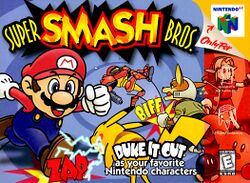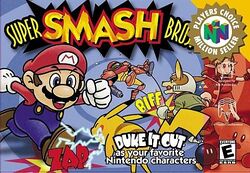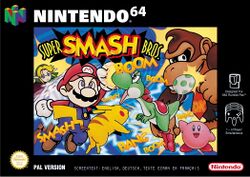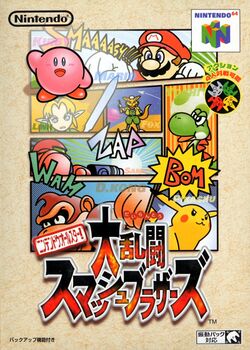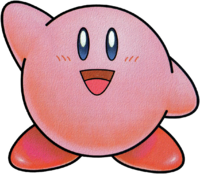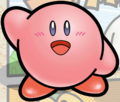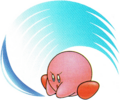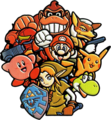Super Smash Bros.: Difference between revisions
mNo edit summary |
Pinkyoshifan (talk | contribs) mNo edit summary |
||
| (64 intermediate revisions by 21 users not shown) | |||
| Line 1: | Line 1: | ||
{{ | {{DISPLAYTITLE:''{{PAGENAME}}''}}{{Infobox-Game | ||
{{Infobox-Game | |image= | ||
|image=[[File:SSB. | <tabs> | ||
|caption= | <tab name="US box art"> | ||
[[File:SSB Box Art.jpg|250px]] | |||
</tab> | |||
<tab name="US box art (Player's Choice)"> | |||
[[File:SSB Boxart Players Choice.jpg|250px]] | |||
</tab> | |||
<tab name="European box art"> | |||
[[File:SSB European Boxart.jpg|250px]] | |||
</tab> | |||
<tab name="Japanese box art"> | |||
[[File:SSB Japanese Boxart.jpg|250px]] | |||
</tab> | |||
</tabs> | |||
|caption=Box art for '''''Super Smash Bros.''''' from various regions. | |||
|developer=[[HAL Laboratory]] | |developer=[[HAL Laboratory]] | ||
|publisher=[[Nintendo]] | |publisher=[[Nintendo]] | ||
|designer=[[Masahiro Sakurai]] | |designer=[[Masahiro Sakurai]] | ||
|released={{ | |released='''Nintendo 64''':<br>{{Released|Japan|January 21, 1999|NA|April 26, 1999|Europe|November 19, 1999}}<br>'''iQue Player''':<br>{{Released|China|November 15, 2005}}<br>'''Virtual Console (Wii)''':<br>{{Released|Japan|January 20, 2009|Europe|June 12, 2009|NA|December 21, 2009}} | ||
|platforms=[[Nintendo 64]], [[Wii]] [[Virtual Console]] | |language={{languages|jp=y|en_us=y|en_gb=y|fr_fr=y|de=y|zh_simp=y}} | ||
|rating={{ratings|esrb=e|pegi=7|cero=a}} | |||
|platforms=[[Nintendo 64]], iQue Player, [[Wii]] [[Virtual Console]] | |||
|successor=''[[Super Smash Bros. Melee]]'' | |successor=''[[Super Smash Bros. Melee]]'' | ||
}} | }}{{SmashWiki}} | ||
{{About|the game for the Nintendo 64|the series as a whole|[[Super Smash Bros. (series)]]}} | |||
'''''Super Smash Bros.''''' is the first game of the ''Super Smash Bros.'' series that was released on [[Nintendo 64]] in 1999. Created by [[HAL Laboratory]], it is the only ''Super Smash Bros.'' game with an E rating by the ESRB; while ''[[Super Smash Bros. Melee|Melee]]'' and ''[[Super Smash Bros. Brawl|Brawl]]'' are rated T, and ''[[Super Smash Bros. for Nintendo 3DS / Wii U|for 3DS / Wii U]]'' and ''[[Super Smash Bros. Ultimate|Ultimate]]'' are rated E10+. | |||
''Super Smash Bros.'' was ported to the iQue Player on November 15, 2005, and is the only iQue Player game to feature Kirby. ''Super Smash Bros.'' was also ported to the [[Wii]]'s Virtual Console in 2009. | |||
==Characters== | ==Characters== | ||
There are twelve playable characters in ''Super Smash Bros.'', eight of which are available from the start, and four of which are unlockable. Each character has three special moves and many basic attacks. Kirby's special moves include [[Inhale]], [[ | There are twelve playable characters in ''Super Smash Bros.'', eight of which are available from the start, and four of which are unlockable. Each character has three special moves and many basic attacks. Kirby's special moves include [[Inhale]], [[Final Cutter]], and [[Stone]]. | ||
===Starter Characters=== | ===Starter Characters=== | ||
*[[smashwiki:Kirby (SSB)|Kirby]] | *[[smashwiki:Kirby (SSB)|Kirby]] | ||
| Line 33: | Line 50: | ||
==Kirby (as a fighter)== | ==Kirby (as a fighter)== | ||
[[File:Kirby | [[File:SSB Kirby artwork.png|thumb|200px|right|Kirby's artwork from ''Super Smash Bros.'']] | ||
Kirby is one of the eight starter characters in this game. He is notable for his small stature, light weight (with only Jigglypuff being lighter), and multiple | Kirby is one of the eight starter characters in this game. He is notable for his small stature, light weight (with only Jigglypuff being lighter), and multiple midair jumps. Despite his size, many of his attacks have a noticeably long range, with a particularly absurd example being his up-tilt standard attack. His most prominent feature, however, is his [[Inhale]] ability, which allows him to copy the neutral-special moves of every other fighter. This makes him extremely versatile in casual play, and a good fighter for beginners to pick up. | ||
=== | ===Moveset=== | ||
Much of Kirby's entourage of attacks were made up for this game, but some are based on his moves from the ''Kirby'' series. Kirby's attacks are as follows: | Much of Kirby's entourage of attacks were made up for this game, but some are based on his moves from the ''Kirby'' series. Kirby's attacks are as follows: | ||
====Standard Ground==== | ====Standard Ground==== | ||
| Line 60: | Line 77: | ||
====Special==== | ====Special==== | ||
*[[ | *[[Inhale|Vacuum]] - Kirby inhales, which will allow him to swallow up fighters who are close-by (within range of a grab). From there, Kirby can either spit them back out as a temporary [[Star Bullet]], or 'swallow' them to copy their neutral special move (and gain a hat based on the fighter swallowed). Kirby can discard this move by taunting, or will lose it if he is hit by a strong attack (at random). | ||
*[[ | *[[Final Cutter]] - Based on the last hit of the Cutter combo, Kirby takes out a blade, rises into the air, then crashes back down, releasing a shock wave on landing. Kirby can use this move to gain some height when recovering and can grab the ledge with it, but it can be easy to intercept. When falling downward, Kirby can send his opponent flying downward with the blade if timed right. | ||
*[[Stone]] - Kirby transforms into | *[[Stone]] - Kirby transforms into stone and crashes downward. He is invulnerable to all attacks except for grabs while in this form and will damage opponents he collides with while falling. | ||
===Tournament Standing=== | ===Tournament Standing=== | ||
Kirby is currently ranked 2nd on the ''Super Smash Bros.'' tier list - in the S rank behind Pikachu, as produced by the Smashboards community. This is due in large part to his strong and versatile attacks, most notably the disjointed ones. His light weight and numerous jumps also allow him to escape combos that other characters would not be able to. He has good match-ups against most of the rest of the cast, but is on even footing with Mario, and is at a disadvantage against Pikachu. | Kirby is currently ranked 2nd on the ''Super Smash Bros.'' tier list - in the S rank behind Pikachu, as produced by the Smashboards community. This is due in large part to his strong and versatile attacks, most notably the disjointed ones. His light weight and numerous jumps also allow him to escape combos that other characters would not be able to. He has good match-ups against most of the rest of the cast, but is on even footing with Mario, and is at a disadvantage against Pikachu. | ||
Kirby is well-represented in | Kirby is well-represented in SSB64 tournaments and often takes the top positions, which is in stark contrast to his placement in the other games in the series. | ||
==Stages== | ==Stages== | ||
There are nine stages in ''Super Smash Bros.'', with one unlockable stage. The Kirby series' stage is [[smashwiki:Dream Land (SSB)|Dream Land]]. | There are nine stages in ''Super Smash Bros.'', with one unlockable stage. The Kirby series' stage is [[smashwiki:Dream Land (SSB)|Dream Land]]. | ||
*[[smashwiki:Dream Land | *[[smashwiki:Dream Land|Dream Land]] | ||
*[[smashwiki:Saffron City | *[[smashwiki:Saffron City|Saffron City]] | ||
*[[smashwiki:Hyrule Castle | *[[smashwiki:Hyrule Castle|Hyrule Castle]] | ||
*[[smashwiki:Sector Z | *[[smashwiki:Sector Z|Sector Z]] | ||
*[[smashwiki:Congo Jungle | *[[smashwiki:Congo Jungle|Congo Jungle]] | ||
*[[smashwiki:Peach's Castle | *[[smashwiki:Peach's Castle|Peach's Castle]] | ||
*[[smashwiki:Planet Zebes | *[[smashwiki:Planet Zebes|Planet Zebes]] | ||
*[[smashwiki:Yoshi's Island | *[[smashwiki:Yoshi's Island|Yoshi's Island]] | ||
===Unlockable Stages=== | ===Unlockable Stages=== | ||
| Line 84: | Line 101: | ||
==Elements from the ''Kirby'' series== | ==Elements from the ''Kirby'' series== | ||
Beyond having Kirby as a playable fighter and other more superficial elements from the series, ''Super Smash Bros.'' takes many cues from the ''Kirby'' series - most notably ''[[Kirby Super Star]]'', which was the previous major project that director Masahiro Sakurai was involved in. Like ''Super Star'', this game involves characters using multiple jumps to traverse side-scrolling arenas with | Beyond having Kirby as a playable fighter and other more superficial elements from the series, ''Super Smash Bros.'' takes many cues from the ''Kirby'' series - most notably ''[[Kirby Super Star]]'', which was the previous major project that director Masahiro Sakurai was involved in. Like ''Super Star'', this game involves characters using multiple jumps to traverse side-scrolling arenas with [[thin floor]]s, in addition to the characters having several different types of moves activated by simple directional inputs and a [[Guard]] in the form of a shield. (the bubble shield itself resembling the [[Mirror]] ability's Guard) | ||
A number of items can appear during regular matches, a few of which are from the ''Kirby'' series. These include: | A number of items can appear during regular matches, a few of which are from the ''Kirby'' series. These include: | ||
*[[Maxim Tomato]] - A recovery item that can heal up to 100% [[damage]]. Notable in that it does not heal all damage - like its ''Kirby'' series counterparts. | *[[Maxim Tomato]] - A recovery item that can heal up to 100% [[damage]]. Notable in that it does not heal all damage - like its ''Kirby'' series counterparts. | ||
*[[Star Rod]] - A battering item that tosses out up to 16 stars when | *[[Star Rod]] - A battering item that tosses out up to 16 stars when it's swung hard. Based on the object of the same name and appearance from ''[[Kirby's Adventure]]''. | ||
==Legacy== | ==Legacy== | ||
''Super Smash Bros.'' was the first game to feature Kirby as a 3D model. As such, it cemented many aesthetics about Kirby that carry forward to his current design. In addition, this was the first time that Kirby was given a voice, being the first time [[Makiko Ohmoto]] voiced him. Thus, Kirby gained his signature greeting/taunt of 'Hi!' from this game. Kirby's aesthetic from this game would be more-or-less directly translated to the next game in the ''Kirby'' series - ''[[Kirby 64: The Crystal Shards]]''. | ''Super Smash Bros.'' was the first finished game to feature Kirby as a 3D model. As such, it cemented many aesthetics about Kirby that carry forward to his current design. In addition, this was the first time that Kirby [[Kirby's voice|was given a voice]], being the first time [[Makiko Ohmoto]] voiced him. Thus, Kirby gained his signature greeting/taunt of 'Hi!' from this game. Kirby's aesthetic from this game would be more-or-less directly translated to the next game in the ''Kirby'' series - ''[[Kirby 64: The Crystal Shards]]''. | ||
The final boss of the 1-P Game, [[Master Hand]] - would later appear as a [[Mid-Boss]] in ''[[Kirby & | The final boss of the [[smashwiki:Classic Mode|1-P Game]], [[Master Hand]] - would later appear as a [[Mid-Boss]] in ''[[Kirby & The Amazing Mirror]]''. | ||
==Trivia== | ==Trivia== | ||
*Although [[King Dedede]] would not appear as a fighter until ''Brawl'', he can be seen in the background of the 'Dream Land' stage in this game. | *Although [[King Dedede]] would not appear as a fighter until ''Brawl'', he can be seen in the background of the 'Dream Land' stage in this game. | ||
**King Dedede, along with [[fireemblem:Marth|Marth]], [[bulbapedia:Mewtwo (Pokémon)|Mewtwo]] and [[mariowiki:Bowser|Bowser]] were originally going to be in the playable fighters but were later scrapped. | |||
***Mewtwo, Marth and Bowser would become available in ''[[Super Smash Bros. Melee]]'', whilst King Dedede would become playable in ''[[Super Smash Bros. Brawl]]''. | |||
==Gallery== | |||
{{main|Super Smash Bros./gallery}} | |||
<gallery> | |||
SSB Logo.png|English logo | |||
SSB JP Logo.png|Japanese logo | |||
SSB Kirby promo art.png|Artwork of Kirby, as seen on the Japanese box art | |||
SSB Kirby Final Cutter artwork.png|Artwork of Kirby using [[Final Cutter]] | |||
SSB JP Site Secret Factor Kirby Artwork.png|Artwork of Kirby used for the link to the secret factor page of the game's Japanese site | |||
SSB Group Art.png|Group artwork of all eight starter characters | |||
SSB Star Rod artwork.png|Artwork of a [[Star Rod]] | |||
SSB Dream Land background.png|Background for the [[Dream Land]] stage | |||
SSB Whispy Woods model.png|Model of [[Whispy Woods]] | |||
SSB Kirby vs Master Hand screenshot.png|Kirby fighting Master Hand | |||
</gallery> | |||
==Names in other languages== | |||
{{Names | |||
|ja=ニンテンドウオールスター!{{furi|大乱闘|だいらんとう}}スマッシュブラザーズ | |||
|jaR=Nintendō Ōru Sutā! Dairantō Sumasshu Burazāzu | |||
|jaM=Nintendo All-Star! Great Melee Smash Brothers | |||
|zhTrad=Super Smash Bros. | |||
|zhSimp=Super Smash Bros.<br>任天堂明星大乱斗 | |||
|zhSimpR=Rèntiāntáng Míngxīng Dàluàndòu | |||
|zhM=-<br>Nintendo Stars: Great Melee | |||
|fr=Super Smash Bros. | |||
|frM=- | |||
|nl=Super Smash Bros. | |||
|nlM=- | |||
|de=Super Smash Bros. | |||
|deM=- | |||
|it=Super Smash Bros. | |||
|itM=- | |||
|ko=Super Smash Bros. | |||
|koM=- | |||
|pt=Super Smash Bros. | |||
|ptM=- | |||
|ru=Super Smash Bros. | |||
|ruM=- | |||
|es=Super Smash Bros. | |||
|esM=- | |||
}} | |||
{{clear}} | {{clear}} | ||
{{Navbox-SSB}} | |||
{{ | [[Category:Games on Nintendo 64]] | ||
[[Category:Super Smash Bros. series]] | |||
Latest revision as of 00:59, 27 December 2023
| ||||||||||||||||||||
| ||||||||||||||||||||
| ||||||||||||||||||||
|
| ||||||||||||||||||||
- This article is about the game for the Nintendo 64. For the series as a whole, see Super Smash Bros. (series).
Super Smash Bros. is the first game of the Super Smash Bros. series that was released on Nintendo 64 in 1999. Created by HAL Laboratory, it is the only Super Smash Bros. game with an E rating by the ESRB; while Melee and Brawl are rated T, and for 3DS / Wii U and Ultimate are rated E10+.
Super Smash Bros. was ported to the iQue Player on November 15, 2005, and is the only iQue Player game to feature Kirby. Super Smash Bros. was also ported to the Wii's Virtual Console in 2009.
Characters[edit]
There are twelve playable characters in Super Smash Bros., eight of which are available from the start, and four of which are unlockable. Each character has three special moves and many basic attacks. Kirby's special moves include Inhale, Final Cutter, and Stone.
Starter Characters[edit]
Unlockable Characters[edit]
Kirby (as a fighter)[edit]
Kirby is one of the eight starter characters in this game. He is notable for his small stature, light weight (with only Jigglypuff being lighter), and multiple midair jumps. Despite his size, many of his attacks have a noticeably long range, with a particularly absurd example being his up-tilt standard attack. His most prominent feature, however, is his Inhale ability, which allows him to copy the neutral-special moves of every other fighter. This makes him extremely versatile in casual play, and a good fighter for beginners to pick up.
Moveset[edit]
Much of Kirby's entourage of attacks were made up for this game, but some are based on his moves from the Kirby series. Kirby's attacks are as follows:
Standard Ground[edit]
- Neutral - Kirby jabs his opponent rapidly, similar to Vulcan Jab.
- Forward tilt - Kirby does a spinning kick forward - with decent range.
- Up tilt - Kirby kicks upward behind him, dealing damage at a very large range.
- Down tilt - Kirby kicks forward while crouching, sweeping the floor.
- Dash attack - Kirby body slams into the ground. This move may be inspired by King Dedede's body slam.
- Forward smash - Kirby does a strong kick as he steps forward. Based on Spin Kick.
- Up smash - Kirby performs a bicycle kick, doing a back-flip in the process.
- Down smash - Kirby spins with his feet out, hitting on both sides.
Standard Aerial[edit]
- Neutral aerial - Kirby kicks one foot out in front, dealing damage for a good while.
- Forward aerial - Kirby extends both feet out and drills, dealing multiple hits.
- Back aerial - Kirby kicks out with both feet behind, dealing a quick hit.
- Up aerial - Kirby performs the 'Twinkle Star' move, spinning with arms and feet extended outward.
- Down aerial - Kirby drills with both feet downward, which can be used to send foes down.
Throws[edit]
- Forward - Kirby flies up off-screen with his foe, then crashes back down. This move is based on the Air Drop technique.
- Back - Kirby performs a backward suplex on his enemy. Based on the Backdrop ability.
Special[edit]
- Vacuum - Kirby inhales, which will allow him to swallow up fighters who are close-by (within range of a grab). From there, Kirby can either spit them back out as a temporary Star Bullet, or 'swallow' them to copy their neutral special move (and gain a hat based on the fighter swallowed). Kirby can discard this move by taunting, or will lose it if he is hit by a strong attack (at random).
- Final Cutter - Based on the last hit of the Cutter combo, Kirby takes out a blade, rises into the air, then crashes back down, releasing a shock wave on landing. Kirby can use this move to gain some height when recovering and can grab the ledge with it, but it can be easy to intercept. When falling downward, Kirby can send his opponent flying downward with the blade if timed right.
- Stone - Kirby transforms into stone and crashes downward. He is invulnerable to all attacks except for grabs while in this form and will damage opponents he collides with while falling.
Tournament Standing[edit]
Kirby is currently ranked 2nd on the Super Smash Bros. tier list - in the S rank behind Pikachu, as produced by the Smashboards community. This is due in large part to his strong and versatile attacks, most notably the disjointed ones. His light weight and numerous jumps also allow him to escape combos that other characters would not be able to. He has good match-ups against most of the rest of the cast, but is on even footing with Mario, and is at a disadvantage against Pikachu.
Kirby is well-represented in SSB64 tournaments and often takes the top positions, which is in stark contrast to his placement in the other games in the series.
Stages[edit]
There are nine stages in Super Smash Bros., with one unlockable stage. The Kirby series' stage is Dream Land.
- Dream Land
- Saffron City
- Hyrule Castle
- Sector Z
- Congo Jungle
- Peach's Castle
- Planet Zebes
- Yoshi's Island
Unlockable Stages[edit]
Elements from the Kirby series[edit]
Beyond having Kirby as a playable fighter and other more superficial elements from the series, Super Smash Bros. takes many cues from the Kirby series - most notably Kirby Super Star, which was the previous major project that director Masahiro Sakurai was involved in. Like Super Star, this game involves characters using multiple jumps to traverse side-scrolling arenas with thin floors, in addition to the characters having several different types of moves activated by simple directional inputs and a Guard in the form of a shield. (the bubble shield itself resembling the Mirror ability's Guard)
A number of items can appear during regular matches, a few of which are from the Kirby series. These include:
- Maxim Tomato - A recovery item that can heal up to 100% damage. Notable in that it does not heal all damage - like its Kirby series counterparts.
- Star Rod - A battering item that tosses out up to 16 stars when it's swung hard. Based on the object of the same name and appearance from Kirby's Adventure.
Legacy[edit]
Super Smash Bros. was the first finished game to feature Kirby as a 3D model. As such, it cemented many aesthetics about Kirby that carry forward to his current design. In addition, this was the first time that Kirby was given a voice, being the first time Makiko Ohmoto voiced him. Thus, Kirby gained his signature greeting/taunt of 'Hi!' from this game. Kirby's aesthetic from this game would be more-or-less directly translated to the next game in the Kirby series - Kirby 64: The Crystal Shards.
The final boss of the 1-P Game, Master Hand - would later appear as a Mid-Boss in Kirby & The Amazing Mirror.
Trivia[edit]
- Although King Dedede would not appear as a fighter until Brawl, he can be seen in the background of the 'Dream Land' stage in this game.
- King Dedede, along with Marth, Mewtwo and Bowser were originally going to be in the playable fighters but were later scrapped.
- Mewtwo, Marth and Bowser would become available in Super Smash Bros. Melee, whilst King Dedede would become playable in Super Smash Bros. Brawl.
- King Dedede, along with Marth, Mewtwo and Bowser were originally going to be in the playable fighters but were later scrapped.
Gallery[edit]
- Main article: Super Smash Bros./gallery
Artwork of Kirby using Final Cutter
Artwork of a Star Rod
Background for the Dream Land stage
Model of Whispy Woods
Names in other languages[edit]
| Language | Name | Meaning |
|---|---|---|
| Japanese | ニンテンドウオールスター!大乱闘スマッシュブラザーズ Nintendō Ōru Sutā! Dairantō Sumasshu Burazāzu |
Nintendo All-Star! Great Melee Smash Brothers |
| Traditional Chinese | Super Smash Bros. |
- Nintendo Stars: Great Melee |
| Simplified Chinese | Super Smash Bros. 任天堂明星大乱斗 Rèntiāntáng Míngxīng Dàluàndòu | |
| Dutch | Super Smash Bros. | - |
| French | Super Smash Bros. | - |
| German | Super Smash Bros. | - |
| Italian | Super Smash Bros. | - |
| Korean | Super Smash Bros. |
- |
| Portuguese | Super Smash Bros. | - |
| Russian | Super Smash Bros. |
- |
| Spanish | Super Smash Bros. | - |
| ||||||||||||||||||||||||||
